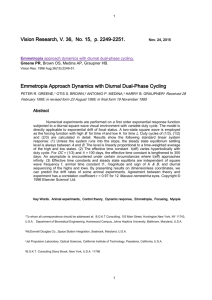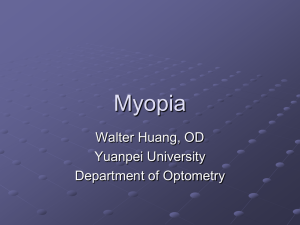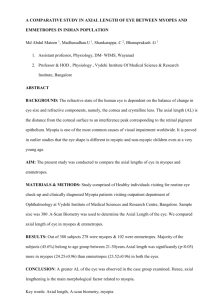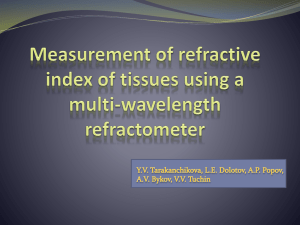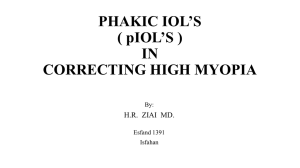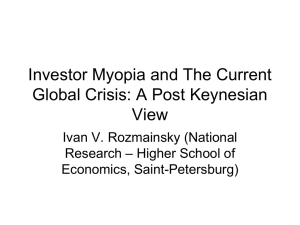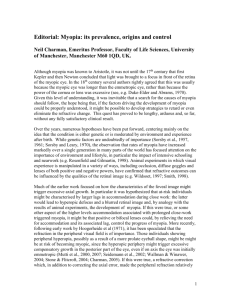as oral presentation, in ppt format, 1508k
advertisement
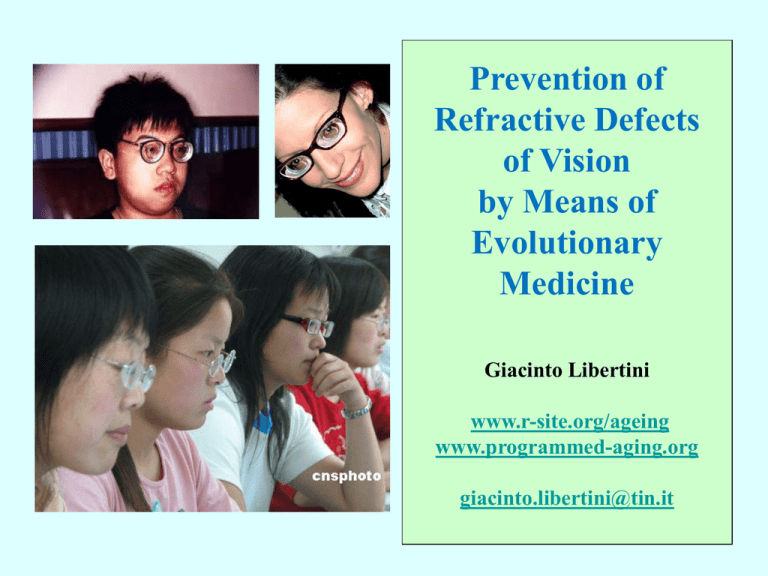
Prevention of Refractive Defects of Vision by Means of Evolutionary Medicine Giacinto Libertini www.r-site.org/ageing www.programmed-aging.org giacinto.libertini@tin.it Preamble What is Evolutionary Medicine? Evolutionary or Darwinian Medicine [1-6] comes into being in 1991 [1], but there are some known forerunners [7] (e.g. [8]) and others not generally cited as forerunners [9,10]. [1] Williams GC, Nesse RM (1991) The dawn of Darwinian medicine. Quart. Rev. Biol. 66, 1-22. [2] Nesse RM, Williams GC (1994) Why we get sick. New York (USA), Times Books. [3] Stearns SC (ed) (1999) Evolution in health and disease (1st ed.). Oxford (UK), Oxford University Press. [4] Trevathan WR, Smith EO, McKenna JJ (eds) (1999) Evolutionary Medicine. New York (USA), Oxford University Press. [5] Trevathan WR, Smith EO, McKenna JJ (eds) (2008) Evolutionary Medicine: new perspectives. New York (USA), Oxford University Press. [6] Stearns SC, Koella JC (eds) (2008) Evolution in health and disease (2nd ed.). Oxford (UK), Oxford University Press. [7] Trevathan WR, Smith EO, McKenna JJ (2008) Introduction and overview of Evolutionary Medicine. In: Trevathan WR, Smith EO, McKenna JJ (eds) Evolutionary Medicine: new perspectives. New York (USA), Oxford University Press. [8] Eaton SB, Shostak M, Konner M (1988) The paleolithic prescription: a program of diet & exercise and a design for living. New York (USA), Harper & Row. [9] Price WA (1939) Nutrition and Physical Degeneration. New York – London, Paul B. Hoeber. [10] Libertini G (1983) Ragionamenti Evoluzionistici. Naples (Italy), Società Editrice Napoletana; English Edition (2011): Evolutionary Arguments. Crownsville (USA), Azinet Press. Evolutionary Medicine is not an Alternative Medicine (like homeopathy, iridology, ayurvedic medicine, naturopathy, traditional Chinese medicine, energy medicine, etc.) but a Medicine that is more thoroughly scientific in that it involves the concepts of Evolutionism. A medicine that ignored the principles of chemistry, for example, would be partially scientific. Similarly, a medicine that ignores the principles of evolution is partially scientific. So, the contrast is not between: Current Medicine Alternative Medicines but between: Current Medicine (which in most cases ignores Evolutionism) Evolutionary Medicine (which is a more thoroughly scientific medicine) However, the first practical question is immediate: Is this difference only a theoretical / verbal nicety? or Does this difference have strong and significant implications for the structure of medical studies and for health organization? Evolutionary Medicine involves applicative consequences. many concepts and Here, I develop a practical application of a simple concept, the “mismatch” [1,2], to the genesis of refractive defects of vision. The concept of “mismatch” is simple but with huge implications: If a species is adapted to a certain range of conditions (including diet, environmental conditions, interrelations with other living beings, etc.), called for brevity “ecological niche”, any change in the ecological niche potentially is a source of disfunctions (diseases), because there is no adaptation to the new conditions. This is defined as "mismatch”. [1] Eaton SB, Shostak M, Konner M (1988) The paleolithic prescription: a program of diet & exercise and a design for living. New York (USA), Harper & Row. [2] Libertini G (2009) Prospects of a Longer Life Span beyond the Beneficial Effects of a Healthy Lifestyle, in: Bentely JV, Keller MA (eds) Handbook on Longevity: Genetics, Diet & Disease, New York (USA), Nova Science Publishers Inc. Refractive Defects of Vision in the Context of Evolutionary Medicine Step 1 - Epidemiological study of modern populations Refractive defects (myopia, astigmatism and hyperopia) are a group of related diseases with frequency: - very common [1-3] - varying greatly from population to population (e.g.: “The prevalence of myopia in Asia is as high as 70-90%, in Europe and America 30-40%, and in Africa 10-20 %” [1]) … [1] Fredrick DR (2002) Myopia. BMJ. 324, 1195-9. [2] Dirani M et al. (2010) Prevalence of refractive error in Singaporean Chinese children: the strabismus, amblyopia, and refractive error in young Singaporean Children (STARS) study. Invest. Ophthalmol. Vis. Sci. 51, 1348-55. [3] Chow YC, Dhillon B, Chew PT, Chew SJ (1990) Refractive errors in Singapore medical students. Singapore Med. J. 31, 472–3. Step 1 - (CONTINUED) … - varying greatly within the same population with changing conditions [1-3] - varying greatly within a population over a short time [2,4,5] (see Figure) [1] Rose KA , Morgan IG, Smith W, Burlutsky G, Mitchell P, Saw S-M (2008) Myopia, lifestyle, and schooling in students of Chinese ethnicity in Singapore and Sydney. Arch. Ophthalmol. 126, 527-30. [2] Cordain, L, Eaton, SB, Miller, JB, Lindeberg, S, Jensen, C (2002) An evolutionary analysis of the aetiology and pathogenesis of juvenileonset myopia. Acta Ophthalmol. Scand. 80, 125–35. [3] Garner LF, Owens H, Kinnear RF, Frith MJ. (1999) Prevalence of myopia in Sherpa and Tibetan children in Nepal. Optom. Vis. Sci. 76, 282-5. [4] Edwards MH, Lam CS (2004). The epidemiology of myopia in Hong Kong. Ann. Acad. Med. Singapore. 33, 34-8. [5] Morgan, RW, Munro, M (1973) Refractive problems in northern natives. Can. J. Ophthalmol. 8,: 226–8. (From [2]:) Figure 1. Moderate myopia (1.00–5.00 D) by age in Indians and Eskimos of the Yukon and NorthWest territories. Adapted from Morgan & Munro (1973) ([5]) Step 2 - Comparison between the frequency of a disease in modern populations and the frequency of the same disease in populations in primitive conditions The study of primitive peoples shows that these defects are very rare or nonexistent among them. As regards Australian Aborigenes: “The marvelous vision of these primitive people is illustrated by the fact that they can see many stars that our race cannot see. In this connection it is authoritatively recorded regarding the Maori of New Zealand that they can see the satellites of Jupiter which are only visible to the white man's eye with the aid of telescopes. These people prove that they can see the satellites by telling the man at the telescope when the eclipse of one of the stars occurs. It is said of these primitive Aborigines of Australia that they can see animals moving at a distance of a mile which ordinary white people can not see at all.” [1] As regards Yakuts (a Siberian people): “Many travelers observed what some of them call ‘telescopic’ eyesight among these peoples. A Yakut distinguished with the naked eye stars in the Pleiades not usually seen without a telescope. The Yakuts say there are many stars in this group, but only seven large ones” [2] … [1] Price, WA (1939) Nutrition and Physical Degeneration. New York – London, Paul B. Hoeber. [2] De Hutorowicz H, Adler BF (1911) Maps of Primitive Peoples. Bull. Amer. Geogr. Soc. 43, 669-79. Step 2 - (CONTINUED) As regards two hunter-gatherer populations: “Using a retinoscope and cycloplegia, Holm (1937) refracted 2364 members (aged 20–65 years) of several hunter-gatherer tribes in Gabon (formerly French Equatorial Africa) in 1936. Of the 3624 eyes examined, only 14 were classified as myopic (nine eyes from − 0.50 to 1.00 D; five eyes from − 3.00 to − 9.00 D), thereby yielding a myopia incidence rate of 0.4%. Similar low rates for myopia were reported by Skeller (1954), who refracted the eyes of 775 Angmagssalik Eskimos as part of a comprehensive anthropological study carried out in 1954. Retinoscopy in conjunction with cycloplegia demonstrated that of the 1123 eyes examined, only 13 (1.2%) were classified as myopic (nine eyes =− 1.00 D; four eyes =− 1.25 D).” [1] “a number of lines of evidence strongly reject the notion that [a] recent (in evolutionary terms) relaxation of natural selection pressures could be responsible for the high incidence of myopia in modern, technological societies.” [1] Data from Step 1 and Step 2 indicate that refractive defects are surely a group of diseases caused by environmental factors, i.e. by presumable mismatch phenomena. [1] Cordain, L, Eaton, SB, Miller, JB, Lindeberg, S, Jensen, C (2002) An evolutionary analysis of the aetiology and pathogenesis of juvenile-onset myopia. Acta Ophthalmol. Scand. 80, 125–35. Step 3 - Hypotheses on the possible changes in the ecological niche underlying the disease and on possible pathogenetical mechanisms Excessive near work, especially using artificial lighting, an improbable condition in the ecological niche to which we are adapted, is a common hypothesis regarding the causes of refractive defects, in particular myopia [1,2]. Against this hypothesis: “In an earlier study of 977 school children (6–17 years of age) on the remote South Pacific island of Vanuatu, Garner et al. (1985) found that only 1.3% of subjects had myopia greater than − 0.25 D, despite engaging in about 8 hrs of school work per day.” [3] Another hypothesis ascribes the epidemic of myopia incidence to dietary alterations, in particular the “increase in high glycaemicload foods” [3]. But, in two homogeneous populations with no detectable difference in dietary habits, incidence of myopia was very different [4]. … [1] Zylbermann R, Landau D, Berson D (1993): The influence of study habits on myopia in Jewish teenagers. J. Pediatr. Ophthalmol. Strabismus 30, 319–22. [2] McBrien NA, Adams DW (1997): A longitudinal investigation of adult-onset and adult-progression of myopia in an occupational group. Refractive and biometric findings. Invest Ophthalmol. 38, 321–33. [3] Cordain L, Eaton SB, Miller JB, Lindeberg S, Jensen C (2002) An evolutionary analysis of the aetiology and pathogenesis of juvenile-onset myopia. Acta Ophthalmol. Scand. 80, 125–35. [4] Rose KA , Morgan IG, Smith W, Burlutsky G, Mitchell P, Saw S-M (2008) Myopia, lifestyle, and schooling in students of Chinese ethnicity in Singapore and Sydney. Arch. Ophthalmol. 126, 527-30. Step 3 – (CONTINUED) A study was made of two homogeneous groups of 6-7-years old children of Chinese ethnicity, living in Singapore and in Sidney, respectively, with the same frequency of myopia in their parents: “Children in Sidney read more books per week (P < .001) and did more near-work activity (P = .002). Children in Sidney spent more time on outdoor activities (13.75 vs 3.05 hours per week) (P < .001)”. The prevalence of myopia was 3.3% in Sidney and 29.1% in Singapore [1]. This suggests that the critical factor is the outdoor activity, alias the exposition to natural light, a hypothesis confirmed by other studies [2,3]. In particular “Higher levels of total time spent outdoors, rather than sport per se, were associated with less myopia” [2]. In these studies, near-work activities appeared to be an independent aggravating factor, but not the main cause of myopia [2,3]. [1] Rose KA, Morgan IG, Smith W, Burlutsky G, Mitchell P, Saw SM (2008) Myopia, lifestyle, and schooling in students of Chinese ethnicity in Singapore and Sydney. Arch. Ophthalmol. 126, 527-30. [2] Rose KA, Morgan IG, Ip J, Kifley A, Huynh S, Smith W, Mitchell P. (2008) Outdoor activity reduces the prevalence of myopia in children. Ophthalmol. 115, 1279-85. [3] Dirani M, Tong L, Gazzard G, Zhang X, Chia A, Young TL, Rose KA, Mitchell P, Saw SM. (2009) Outdoor activity and myopia in Singapore teenage children. Br. J. Ophthalmol. 93, 997-1000. Step 4 - Study of the mechanisms linking alterations of the ecological niche to the pathogenesis of the disease It is known – from experiments on chickens - that the application (for 7 days, beginning at 5 days of age), of spherical defocus lenses or of translucent occluders to one eye, or exposure to constant light, cause astigmatism associated with myopia or hyperopia. In control birds, astigmatism is normal at birth and disappears, or decreases, over the following days [1]. Similar results were obtained in monkeys [2]. In our species too, astigmatism is normal at the birth and disappears in the first years of life: “Infants have a high incidence of clinically significant astigmatism.” “Of 28 children who had large amounts of astigmatism in the first year, all showed elimination or a large reduction in the amount of the cylindrical error by 4 years” [3] “Full term newborn babies are known to be on average hypermetropic at birth. Preterm babies tend to be myopic when examined at an age corresponding to term …” [4] [1] Kee CS, Deng L (2008) Astigmatism associated with experimentally induced myopia or hyperopia in chickens. Invest. Ophthalmol. Vis. Sci. 49, 858-67. [2] Kee CS, Hung LF, Qiao-Grider Y, Ramamirtham R, Smith EL 3rd. (2005) Astigmatism in monkeys with experimentally induced myopia or hyperopia. Optom. Vis. Sci. 82, 248-60. [3] Gwiazda J, Scheiman M, Mohindra I, Held R (1984. Astigmatism in children: changes in axis and amount from birth to six years. Invest Ophthalmol Vis Sci. 25, 88-92. [4] Varghese RM, Sreenivas V, Mammen Puliye J, Varughese S (2009). Refractive Status at Birth: Its Relation to Newborn Physical Parameters at Birth and Gestational Age. PLoS ONE 4(2): e4469. Step 4 – (CONTINUED) Thus, at birth, the eye is imperfect. The image is focused either too far forward or too far behind the retina. There is also a deformation of the image on one plane versus the other (astigmatism). The genetic program of eye development means that, at birth, an eye will have only approximate vision. Immediately after birth, it is activated another program that modulates the further development of the eye in order to achieve optimum vision. Step 4 – (CONTINUED) In other words, these data indicate that, at birth, the eye is hyperopic (a little too short) or myopic (a little too long) and astigmatic (different curvature on the vertical vs the horizontal plane). In the first period of life, by means of neurological and morphogenetic mechanisms, the length and the curvatures of the eye are adapted to obtain the achieve the best possible vision (“emmetropization”). It is like a camera with a very sophisticated autofocus capacity in its rest position (remote viewing): when it comes out of the factory, it is not focused, but it achieves, by itself, an optimal hardware focusing for remote viewing IF WE RESPECT THE MANUFACTURER’S INSTRUCTIONS (e.g.: do NOT point the camera at anything which is too dark or too bright!). Well, our eye / camera has a hardware focusing capacity only in the first period of life, and it is essential that the conditions are similar to the those to which our species is adapted. In different conditions, proper functioning is not guaranteed and malfunction is probable! Step 5 – Possible restoration of the normal, i.e. primeval, conditions or possible compensatory conditions Under modern conditions of life, particularly in urban areas with high population densities, it is "normal" that babies do not grow up outdoors, with exposure to natural light. It is a widespread belief that babies should be protected as much as possible from the external environment, in particular from direct exposure to sunlight, as this will damage them in some way. Many infants spend their first months of life almost exclusively indoors, only exposed to artificial lighting, with uneven and weak brightness, and, in all cases, under conditions quite different from those to which our species is adapted. For proper eye development, babies should be exposed as much as possible to natural light conditions; sunlight should not be avoided and conditions should be as similar as possible to the original ones. Step 6 - Analysis of the results achieved and ideation and proposal of further improvements Such measures should be applied on a large scale, because evidence indicates that the current epidemic of refractive defects is caused by alterations in the exposure rate to natural light in infants and children. Selected groups of infants and children, growing up under various conditions of compliance with these guidelines, should be carefully monitored from an ophthalmologic point of view and compared with control groups that fail to comply with them. It would be essential to know how much the exposure to natural light is needed to prevent the occurrence of refractive defects. First Objection Before applying these measures of prevention on a large scale, observation of controlled groups in order to confirm their validity is necessary. But this objection would be generated by a contradiction of current Medicine. In fact, when a new drug is proposed, we rightly expect a series of experiments, in several stages, before its use is authorized. Meanwhile, the NON-use of the drug is considered to be due and NOT subject to preventive experimentation. On the contrary, in the case of a new habit of life, alias a change of the ecological niche, the new habit is introduced and accepted WITHOUT any trial that demonstrates its safety. Now, If a new NOT tested habit of life is suspected of causing illness, the indication to stop this habit of life is rightful and proper. Why, before its suspension, should we demonstrate its harmfulness and the benefits resulting from its suspension? Such an absurd principle has been used for decades to extend the use of smoke without that smokers were at least warned of the deadly risks they were running. Again, a new habit (smoking) was introduced without any evidence that proved its safety and for decades it was claimed that its harm should be proved before taking action against it. After many scientific tests (while the slaughter continued) Any change of the ecological niche to which a species is adapted must be considered potentially harmful until the contrary is proved. In the case of a new drug, this principle is observed! [Precautionary principle] But for other modifications of the ecological niche, no precaution is taken. It is presumed – irrationally and stupidly, because of nonscientific evaluations – that a modification must not be considered harmful until the experience proves the contrary! [Imprudence Principle] The correct scientific logic would be to take steps against a change in the ecological niche on the sole grounds of the suspicion that this change is bad and BEFORE the sure demonstration in irreproachable scientific terms. Afterwards, the results in populations (or fractions of populations), which pursue - to a greater or lesser extent - the restoration of more physiological (alias natural) conditions must be compared both to confirm the expected results and for evaluating other possible measures. But one should not expect the results of test samples before applying the aforesaid preventive actions on a large scale. For refractive defects the case is analogous. It is not acceptable to wait decades of experimentation to prove that the restoration of conditions closer to the natural ones can dramatically reduce the incidence of refractive disorders. Measures of increased exposure to natural light conditions from the newborn age must be propagandized and applied on a large scale. Afterwards, the results in populations, and fractions of populations, which apply to a greater or lesser extent the restoration of more physiological, alias natural, conditions must be compared both to confirm the expected results and for evaluating the necessary degree of exposure to natural light for optimal results. But one should not expect the results of test samples before applying the aforesaid preventive actions on a large scale. Second Objection The refractive defects should be attributed to the combination of environmental and genetic factors. This is a misleading way of describing the case. Certainly, when an individual is exposed to an ecological niche to which its genes are not adapted, in the diseases that are caused by the altered ecological niche, his genes, which are more or less resistant to the onset of diseases, come into play. But, we cannot and should not consider the genes that are less resistant to the diseases as pathological: they are entirely normal genes that in new conditions, to which the species is not adapted, have responses that are more or less effective against the onset of pathological changes. For example, our species is certainly not adapted to smoking. If, in smokers, some suffer respiratory failure, others chronic bronchitis and others cancer, it is not correct to say that those who develop these diseases have bad genes that somehow must be corrected, or for which it is necessary to develop opportune treatments. The logic says that we must avoid the alteration of the ecological niche and thus prevent the development of diseases that result from it. It should be noted that in some cases refractive defects are actually due to a genetic alteration. In these cases any preventive measure is not able to prevent the disease. But, if we refer to data from the study of populations living under primitive conditions, the incidence of such cases is less than 1%. Therefore, the attribution of responsibility to genetic factors should not be an excuse to diminish or avoid to address the most attention and efforts on prevention. Conclusion Refractive defects involve significant costs arising from the adoption of artificial means to correct refraction (lenses, contact lenses, lenses inserted artificially, laser surgery or other methods). In cases where the defects are of high grade, there are complications that involve additional costs, worsening vision and often involve the loss of sight. Even in cases where there is no loss of sight, artificial means of correction only partially remedy the defect and are a source of limitation or disability for many activities. Overall, refractive defects involve significant costs and reduced quality of life. Current Medicine is directed to pursue means of correction that are increasingly sophisticated and refined. But the best goal would certainly be to minimize new cases of refractive defects, reserving the cures to exceptional cases. This would limit the degradation of quality of life, a lot of suffering, and - last but something to be reckoned with - rising costs. This is possible with the correct application of trivial principles of Evolutionary Medicine. … Conclusion - (CONTINUED) Modern doctors, largely unaware even of the most basic principles of Evolutionism, do not know these possibilities. At the same time, evolutionary biologists are unaware of the extreme importance of these possibilities for a rational organization of a health system that should primarily prevent diseases. It is therefore essential the integration of the knowledge of Evolutionism into the active body of current Medicine, transforming it into Evolutionary Medicine. Thanks for your attention This presentation is on my personal pages too: www.r-site.org/ageing (e-mail: giacinto.libertini@tin.it)
